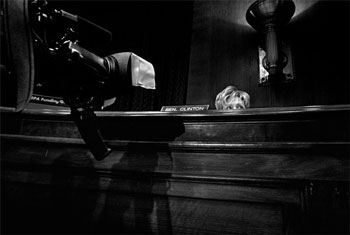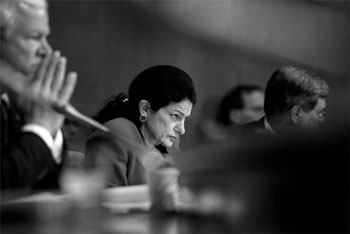 |
→ February 2005 Contents → feature
|
Changing the Face of Power: Women in the U.S. Senate
February 2005
|
 |
||||||
|
It took 200 years for the first woman to be elected to the U.S. Senate in her own right. In 1978, Nancy Kassebaum of Kansas was voted into office without having previously filled an unexpired Congressional term. In 1992, there were two women senators and by 2001, the number had grown to 13. Today, a record 14 women hold this prestigious office. These women are transforming this powerful branch of our government.
Gaining access to these senators and earning their trust proved to be challenging, but Mara nevertheless succeeded in photographing a majority of them during a three-year period from 2001 to 2003. Through great patience and careful observation, she got beyond orchestrated photo ops, finding real moments in tightly controlled events. Further, she convinced the senators to allow her to shadow them when no other media was present while they conducted staff meetings, held hearings, and paused to catch their breath. Mara's intent was to portray the senators candidly both as politicians and as human beings, while capturing the complexity of their days. As a purist documentary photographer, Mara favors ambient light. For this project, she worked with Fuji 800 professional color film, pushing it to 1600 to minimize the use of flash. She then made large scans from the negatives. Through Photoshop she converted the scans to gray scale and made prints. She chose black-and-white images for this project due to the subtle nature of political photography. She felt that color would distract from actions taking place in the images that conveyed the story. As she continued work on the project, Mara realized its scope had grown beyond publication in a magazine and that its content would be better conveyed in the form of a book and/or an exhibit. With support from The Center for American Women and Politics, a unit of the Eagleton Institute of Politics at Rutgers University, she attracted the attention of the staff at the Smithsonian Institution's Arts and Industries Building. They agreed to showcase her work in an exhibit that was displayed in May 2003. Aware of her project, fellow photojournalist PF Bentley introduced Mara to Dr. Don Carleton, director of the University of Texas at Austin Center for American History (CAH).
Dr. Carleton immediately recognized that Mara's unique documentary portrait of the women serving as U.S. senators captured a defining moment in American history. He persuaded her to place her photographic collection in the Center's News Media History Archive with the collections of other prominent journalists, photographers, filmmakers, and television professionals. "Partnering with Melina was an easy decision to make. It was clear to me that her work would be a valuable resource for students and researchers interested in women's history as well as the history of the Congress. Melina is an outstanding photojournalist and we are delighted and honored to be associated with her." The Melina Mara Collection is also a strong addition to CAH political collections. All are available for research, not only to the University community, but also to anyone agreeing to the rules for use of the collections. Dr. Carleton also proposed to publish Mara's book through CAH's Focus on American History series at the University of Texas Press. This book is scheduled to be released in fall 2005. In addition to accepting Mara's archive and publishing her book, CAH has made her exhibition of 38 black-and-white lambda prints available to museums and universities across the country, including the Women's Museum in Dallas, The Humphrey Institute at the University of Minnesota in Minneapolis, and the Museum of History and Industry in Seattle. It is currently on display in Austin at CAH's Research and Collections division. The signature photograph of the exhibition is that of Senator Kay Bailey Hutchison with her daughter, Bailey, taken in 2002 at the first September 11 ceremony following the attacks on the World Trade Center. Taking place on the Capitol steps, the legislators were lined up appearing as a wall of men in black suits. Sen. Hutchison had brought her daughter to the ceremony but Bailey wanted to play in the fountain behind the men instead of standing with them. So Sen. Hutchison stepped away to retrieve her. As the senator and her reluctant child walked back to the line, Mara snapped the photograph. In her interview in this edition of The Digital Journalist, Mara recounts the speed and luck needed to capture this image. She also realized its strong symbolism of a woman entering a profession historically reserved for males. Numerous, strong themes are present in Mara's body of work. One woman among many men is captured in several of the images, notably that of Alaska Senator Lisa Murkowski during President Bush's State of the Union speech in 2003. The intensity of their job can be seen in the faces of Maine Senator Olympia Snowe and California Senator Barbara Boxer, both listening to testimony in different hearings. Camaraderie between the women at an unofficial coalition meeting is evident as Arkansas Senator Blanche Lincoln gives a thumbs-up gesture to Sen. Boxer during a reception. A photograph of Louisiana Senator Mary Landrieu reveals her style in approaching her constituents. The changing of the guard is illustrated by an image of former Kansas Senator Bob Dole and his wife, North Carolina Senator Elizabeth Dole, on their way to her swearing-in ceremony. To complement Mara's photographs, veteran White House journalist Helen Thomas conducted face-to-face audio interviews with most of the senators. Photojournalists David Snider and Sandra Eisert produced a video on Mara's project that can be seen on the Photography Channel at http://www.photographychannel.tv/. "For the first time, it is conceivable that a woman could rise from the Senate to launch a serious bid for the presidency. When we work together, we make change," says Maryland Senator Barbara Mikulski, dean of the women members. "Mara's photographs help us understand the evolution that makes such hopes not only possible but reasonable." The Center for American History is pleased to sponsor and to present this feature on Melina Mara in The Digital Journalist.
© Alison Beck
Associate Director at the University of Texas Center for American History
|
|||||||
Back to February 2005 Contents
|
|

